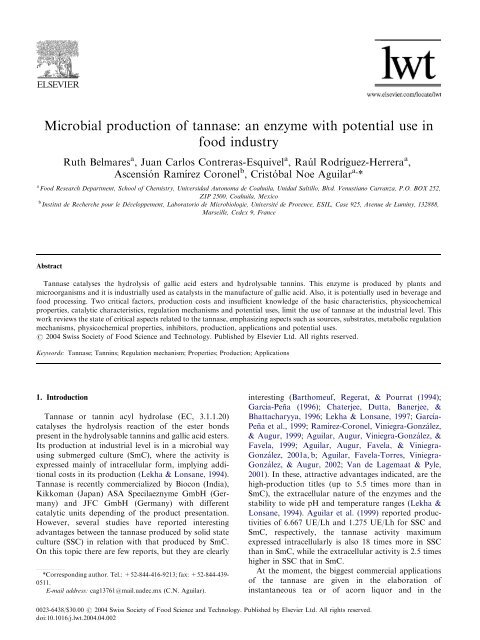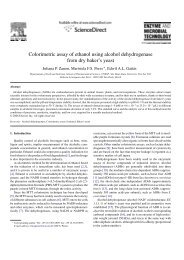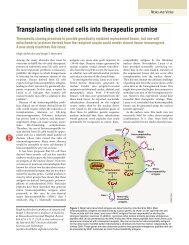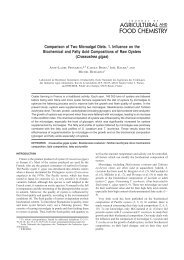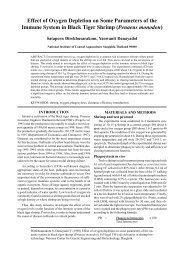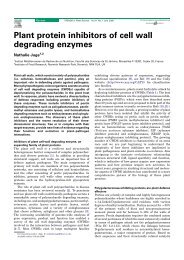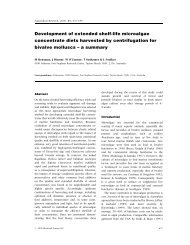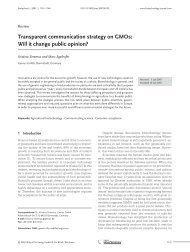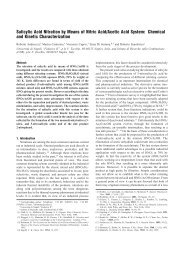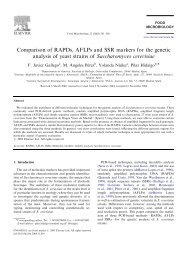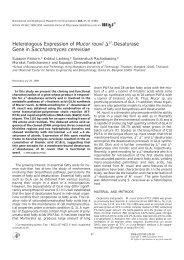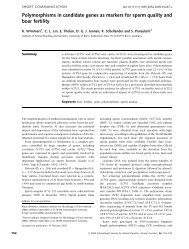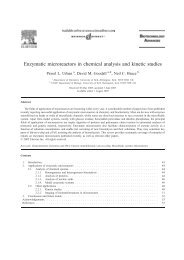Microbial production of tannase - Aseanbiotechnology.info
Microbial production of tannase - Aseanbiotechnology.info
Microbial production of tannase - Aseanbiotechnology.info
Create successful ePaper yourself
Turn your PDF publications into a flip-book with our unique Google optimized e-Paper software.
<strong>Microbial</strong> <strong>production</strong> <strong>of</strong> <strong>tannase</strong>: an enzyme with potential use in<br />
foodindustry<br />
Ruth Belmares a , Juan Carlos Contreras-Esquivel a ,Ra!ul Rodr!ıguez-Herrera a ,<br />
Ascensi!on Ram!ırez Coronel b , Crist!obal Noe Aguilar a, *<br />
a Food Research Department, School <strong>of</strong> Chemistry, Universidad Autonoma de Coahuila, Unidad Saltillo, Blvd. Venustiano Carranza, P.O. BOX 252,<br />
ZIP 2500, Coahuila, Mexico<br />
b Institut de Recherche pour le Développement, Laboratorio de Microbiologie, Université de Provence, ESIL, Case 925, Avenue de Luminy, 132888,<br />
Marseille, Cedex 9, France<br />
Abstract<br />
Tannase catalyses the hydrolysis <strong>of</strong> gallic acid esters and hydrolysable tannins. This enzyme is produced by plants and<br />
microorganisms and it is industrially used as catalysts in the manufacture <strong>of</strong> gallic acid. Also, it is potentially used in beverage and<br />
food processing. Two critical factors, <strong>production</strong> costs and insufficient knowledge <strong>of</strong> the basic characteristics, physicochemical<br />
properties, catalytic characteristics, regulation mechanisms andpotential uses, limit the use <strong>of</strong> <strong>tannase</strong> at the industrial level. This<br />
work reviews the state <strong>of</strong> critical aspects relatedto the <strong>tannase</strong>, emphasizing aspects such as sources, substrates, metabolic regulation<br />
mechanisms, physicochemical properties, inhibitors, <strong>production</strong>, applications and potential uses.<br />
r 2004 Swiss Society <strong>of</strong> Food Science and Technology. Published by Elsevier Ltd. All rights reserved.<br />
Keywords: Tannase; Tannins; Regulation mechanism; Properties; Production; Applications<br />
1. Introduction<br />
Tannase or tannin acyl hydrolase (EC, 3.1.1.20)<br />
catalyses the hydrolysis reaction <strong>of</strong> the ester bonds<br />
present in the hydrolysable tannins and gallic acid esters.<br />
Its <strong>production</strong> at industrial level is in a microbial way<br />
using submergedculture (SmC), where the activity is<br />
expressedmainly <strong>of</strong> intracellular form, implying additional<br />
costs in its <strong>production</strong> (Lekha & Lonsane, 1994).<br />
Tannase is recently commercializedby Biocon (India),<br />
Kikkoman (Japan) ASA Specilaeznyme GmbH (Germany)<br />
andJFC GmbH (Germany) with different<br />
catalytic units depending <strong>of</strong> the product presentation.<br />
However, several studies have reported interesting<br />
advantages between the <strong>tannase</strong> produced by solid state<br />
culture (SSC) in relation with that produced by SmC.<br />
On this topic there are few reports, but they are clearly<br />
*Corresponding author. Tel.: +52-844-416-9213; fax: +52-844-439-<br />
0511.<br />
E-mail address: cag13761@mail.uadec.mx (C.N. Aguilar).<br />
ARTICLE IN PRESS<br />
interesting (Barthomeuf, Regerat, & Pourrat (1994);<br />
Garc!ıa-Pen˜ a (1996); Chaterjee, Dutta, Banerjee, &<br />
Bhattacharyya, 1996; Lekha & Lonsane, 1997; Garc!ıa-<br />
Pen˜ a et al., 1999; Ram!ırez-Coronel, Viniegra-Gonz!alez,<br />
& Augur, 1999; Aguilar, Augur, Viniegra-Gonz!alez, &<br />
Favela, 1999; Aguilar, Augur, Favela, & Viniegra-<br />
Gonz!alez, 2001a, b; Aguilar, Favela-Torres, Viniegra-<br />
Gonz!alez, & Augur, 2002; Van de Lagemaat & Pyle,<br />
2001). In these, attractive advantages indicated, are the<br />
high-<strong>production</strong> titles (up to 5.5 times more than in<br />
SmC), the extracellular nature <strong>of</strong> the enzymes andthe<br />
stability to wide pH and temperature ranges (Lekha &<br />
Lonsane, 1994). Aguilar et al. (1999) reportedproductivities<br />
<strong>of</strong> 6.667 UE/Lh and1.275 UE/Lh for SSC and<br />
SmC, respectively, the <strong>tannase</strong> activity maximum<br />
expressedintracellularly is also 18 times more in SSC<br />
than in SmC, while the extracellular activity is 2.5 times<br />
higher in SSC that in SmC.<br />
At the moment, the biggest commercial applications<br />
<strong>of</strong> the <strong>tannase</strong> are given in the elaboration <strong>of</strong><br />
instantaneous tea or <strong>of</strong> acorn liquor andin the<br />
0023-6438/$30.00 r 2004 Swiss Society <strong>of</strong> Food Science and Technology. Published by Elsevier Ltd. All rights reserved.<br />
doi:10.1016/j.lwt.2004.04.002
<strong>production</strong> <strong>of</strong> the gallic acid (Coggon, Graham, &<br />
Sanderson, 1975; Chae & Yu, 1983; Pourrat, Regerat,<br />
Pourrat, & Jean, 1985; Garc!ıa-N!ajera, 2002), which is an<br />
important intermediary compound in the synthesis <strong>of</strong><br />
the antibacterial drug, trimetroprim, used in the<br />
pharmaceutical industry (Sittig, 1988) andalso in the<br />
foodindustry; gallic acidis a substrate for the chemical<br />
or enzymatic synthesis <strong>of</strong> the propylgallate, a potent<br />
antioxidant. Also, the <strong>tannase</strong> is used as clarifying agent<br />
in some wines, juices <strong>of</strong> fruits andin refreshing drinks<br />
with c<strong>of</strong>fee flavour (Lekha, Ramakrishna, & Lonsane,<br />
1993).<br />
In the case <strong>of</strong> the wines, it is important to state that<br />
the main tannins present are catechins andepi-catechins,<br />
which can get a complex with galacto-catechins and<br />
others galloyl-derivated. The amount <strong>of</strong> catechin in<br />
white wines is around<strong>of</strong> 10 to 50 mg/l, while in other<br />
wines it can reach 800 mg/l (Ribereau-Gayon, 1973).<br />
Fifty percent <strong>of</strong> the colour <strong>of</strong> the wines is due to the<br />
presence <strong>of</strong> the tannins, however, if these compounds<br />
are oxidized to quinones by contact with the air it could<br />
be formed an undesirable turbidity, presenting severe<br />
quality problems. The use <strong>of</strong> the <strong>tannase</strong> can be a<br />
solution to these problems.<br />
In the manufacture <strong>of</strong> beer, the <strong>tannase</strong> couldbe used<br />
since the tannins are present in low quantities. When the<br />
proteins <strong>of</strong> the beer are in considerably high quantities<br />
an undesirable turbidity is presented by the accomplishing<br />
with these tannins. This problem couldbe resolved<br />
with the employment <strong>of</strong> the <strong>tannase</strong>. The tannery<br />
effluents contains high amounts <strong>of</strong> tannins, mainly<br />
polyphenols, which are dangerous pollutants, for this<br />
reason the use <strong>of</strong> the <strong>tannase</strong> represents a cheap<br />
treatment andcash for the removal <strong>of</strong> these compounds.<br />
2. Tannase substrates<br />
Tannins are widely distributed in different parts<br />
(bark, needles, heartwood, grasses, seeds and flowers)<br />
<strong>of</strong> vascular plants. They are a group <strong>of</strong> complex<br />
oligomeric chains substances characterizedby the<br />
presence <strong>of</strong> polyphenolic compounds. They have molecular<br />
weight higher than 500, reaching values above<br />
20000 kDa. One <strong>of</strong> the major characteristic <strong>of</strong> tannins is<br />
its ability to form strong complexes with protein and<br />
other macromolecules such as starch, cellulose and<br />
minerals. Tannins are classifiedin two major groups:<br />
hydrolysable and condensed tannins (Lekha & Lonsane,<br />
1997; Aguilar & Gutiérrez-S!anchez, 2001).<br />
The hydrolysable tannins are constituted by several<br />
molecules <strong>of</strong> organic acids, such as gallic, ellagic, digallic<br />
andchebulic acids, esterifiedto a molecule <strong>of</strong> glucose.<br />
Molecules with a core <strong>of</strong> quinic acidinstead<strong>of</strong> glucose<br />
have been also considered as hydrolysable tannins.<br />
ARTICLE IN PRESS<br />
Fig. 1 presents some examples <strong>of</strong> hydrolysable tannins<br />
(Mueller-Harvey, 2001).<br />
In order to maintain its binding capacity, gallotannins<br />
must have more than two gallic acidconstituents<br />
esterifiedto the glucose core. Hydrolysable tannins can<br />
be easily hydrolysed under mild acid or alkaline<br />
conditions; with hot water or enzymatically (L!opez-<br />
R!ıos, 1984).<br />
Condensed tannins or Proanthocyanidins (Fig. 2) are<br />
complex compounds constituted by flavonoid groups<br />
(from 2 to 50) which are considered not to be<br />
hydrolysable. Their major constituents are cyanidin<br />
and delphinidin which are responsible for the astringent<br />
taste <strong>of</strong> fruit andwines (Sanchez, 2001).<br />
The negative effect <strong>of</strong> tannins in animal nutrition is<br />
due to their capacity to bind macromolecules rendering<br />
them undigestible (Mendez, 1984). Tannins form stable<br />
complex with enzymes andminerals requiredfor the<br />
ruminal microorganisms. They are also responsible <strong>of</strong> a<br />
bitter taste, which considerably reduces the feed intake.<br />
However, low tannin concentrations in feedhave<br />
demonstrated to increase nitrogen assimilation in<br />
ruminants, rendering higher growth rates and milk<br />
<strong>production</strong> (Nip & Burns, 1969).<br />
3. Tannase<br />
Tannase catalyses the breakdown <strong>of</strong> hydrolysable<br />
tannins such as tannic acid, methygallate, ethyl gallate,<br />
n-propylgallate andisoamylgallate. A typical reaction <strong>of</strong><br />
<strong>tannase</strong> is the hydrolytic cleavage <strong>of</strong> (-)epigallocatechin-<br />
3-ol gallate (Fig. 3) (Bajpai & Patil, 1997; Lekha &<br />
Lonsane, 1997).<br />
Although <strong>tannase</strong> is present in plants, animals and<br />
microorganisms, it is mainly produced by microorganisms<br />
(Ayed& Hamdi, 2002; Nishitani & Osawa, 2003).<br />
Table 1 presents some <strong>of</strong> the microorganisms studies for<br />
<strong>tannase</strong> <strong>production</strong>.<br />
Tannase <strong>production</strong> and application have been<br />
extensively studied, studies related to strain isolation<br />
andimprovement, process development andapplication<br />
<strong>of</strong> <strong>tannase</strong>s have conducted to a great number <strong>of</strong><br />
scientific publications andpatents. Table 2 presents<br />
some <strong>of</strong> the publishedpatents regarding <strong>tannase</strong><br />
<strong>production</strong> and application.<br />
4. Production <strong>of</strong> <strong>tannase</strong><br />
Filamentous fungi <strong>of</strong> the Aspergillus genus have been<br />
widely used for <strong>tannase</strong> <strong>production</strong>. Although <strong>tannase</strong><br />
<strong>production</strong> by Aspergillus can occur in the absence <strong>of</strong><br />
tannic acid, this fungi tolerates tannic acid concentrations<br />
as high as 20% without having a deleterious effect<br />
on both growth and enzyme <strong>production</strong>. Studies on
HO<br />
HO<br />
HO<br />
HO<br />
(B)<br />
OH<br />
OH<br />
(D)<br />
HO<br />
(A)<br />
HO<br />
HO<br />
O<br />
C<br />
O<br />
C<br />
HO<br />
HO<br />
HO<br />
HO<br />
HO<br />
HO<br />
O<br />
O<br />
HO<br />
HO<br />
O<br />
C=O<br />
OH OH<br />
OH<br />
OH<br />
O<br />
C<br />
ARTICLE IN PRESS<br />
O<br />
O<br />
COOH<br />
COOH<br />
O<br />
C=O<br />
O<br />
O<br />
C<br />
C<br />
O<br />
O<br />
OH OH<br />
O<br />
OH<br />
O<br />
C<br />
OH<br />
O<br />
Fig. 1. Hydrolysable tannins and some <strong>of</strong> their constituents. A. Gallotannin, B. Ellagitannin, C. Ellagic acid, D. Hexahydroxyphenic acid and E.<br />
Gallic acid.<br />
HO<br />
HO<br />
HO<br />
O<br />
OH<br />
OH<br />
HO OH<br />
HO<br />
HO<br />
O<br />
OH<br />
OH<br />
OH<br />
OH<br />
OH<br />
Fig. 2. Condensed tannins or Proanthocyanidins.<br />
O<br />
O<br />
OH<br />
OH<br />
OH<br />
HO<br />
O<br />
OH<br />
OH<br />
O<br />
C<br />
OH<br />
OH<br />
HO<br />
(C)<br />
HO<br />
O<br />
OH<br />
O<br />
OH<br />
(E)<br />
O<br />
HO<br />
O<br />
C<br />
O<br />
HO<br />
OH<br />
HO<br />
HO<br />
O<br />
OH<br />
O<br />
OH<br />
OH<br />
OH<br />
OH<br />
OH<br />
OH<br />
COOH<br />
O<br />
OH<br />
OH<br />
O<br />
O<br />
C<br />
OH<br />
HOOC<br />
Fig. 3. Typical reaction <strong>of</strong> <strong>tannase</strong>.<br />
OH<br />
OH<br />
OH<br />
OH<br />
OH<br />
OH<br />
OH<br />
OH
<strong>tannase</strong> <strong>production</strong> by Aspergillus have been carriedout<br />
on submergedandsolidstate cultures. Depending on the<br />
strain andthe culture conditions, the enzyme can be<br />
constitutive or inducible, showing different <strong>production</strong><br />
patterns. Phenolic compounds such as gallic acid,<br />
pyrogallol, methyl gallate andtannic acidinduces<br />
<strong>tannase</strong> synthesis (Bajpai & Patil, 1997). However, the<br />
induction mechanism has not been demonstrated and<br />
there is some controversy about the role <strong>of</strong> some <strong>of</strong> the<br />
hydrolysable tannins constituents on the synthesis <strong>of</strong><br />
<strong>tannase</strong> (Deschamps, Otuk, & Lebeault, 1983). For<br />
instance, gallic acid, one <strong>of</strong> the structural constituents <strong>of</strong><br />
some hydrolysable tannins, such as tannic acid, has been<br />
reported as an inducer <strong>of</strong> <strong>tannase</strong> synthesis under<br />
submergedfermentation, whilst it represses <strong>tannase</strong><br />
Table 1<br />
Microorganisms usedfor <strong>tannase</strong> <strong>production</strong><br />
Bacteria Bacillus pumilus<br />
Bacillus polymyxa<br />
Corynebacterium sp<br />
Klebsiella pneumoniae<br />
Streptococcus bovis<br />
Selenomonas ruminantium<br />
Yeast Candida sp.<br />
Saccharomyces cerevisiae<br />
Mycotorula japonica<br />
Fungi Aspergillus niger<br />
Aspergillus oryzae<br />
Aspergillus japonicus<br />
Aspergillus gallonyces<br />
Aspergillus awamori<br />
Penicillium chrysogenum<br />
Rhizopus oryzae<br />
Trichoderma viride<br />
Fusarium solani<br />
Mucor sp.<br />
Table 2<br />
Publishedpatents relatedto <strong>tannase</strong> <strong>production</strong> or application<br />
ARTICLE IN PRESS<br />
synthesis under solid state fermentation. Nevertheless,<br />
independently <strong>of</strong> the involved mechanism, it has been<br />
well acceptedthat due to the complex composition <strong>of</strong><br />
the hydrolysable tannins, some <strong>of</strong> their hydrolysis<br />
products induces <strong>tannase</strong> synthesis (Aguilar et al., 2002).<br />
Addition <strong>of</strong> carbon sources such as glucose, fructose,<br />
sucrose, maltose, arabinose to the culture medium at<br />
initial concentrations from 10 to 30 g/l improves <strong>tannase</strong><br />
<strong>production</strong> by Aspergillus niger. Nitrogen requirements<br />
can be suppliedby different organic andinorganic<br />
sources. Inorganic nitrogen can be supplementedas<br />
ammonium salts (sulphate, carbonate, chloride, nitrate,<br />
monohydrated phosphate) or nitrate salts (sodium,<br />
potassium or ammonium). Other nutritional requirements<br />
such as potassium, magnesium, zinc, phosphate<br />
andsulphur are suppliedas salts. Although A. niger<br />
does not require c<strong>of</strong>actor supplementation, folic and<br />
pantothenic acidare eventually addedto the culture<br />
medium. A typical medium for <strong>tannase</strong> <strong>production</strong> by<br />
Aspergillus niger is presentedin Table 3.<br />
Tannase <strong>production</strong> in submerged culture by Aspergillus<br />
sp. is improvedat high aeration rates. It is<br />
favouredat 30–33 C andinitial pH values from 3.5 to<br />
Table 3<br />
Typical culture medium for <strong>tannase</strong> <strong>production</strong> by Aspergillus niger<br />
Constituent Initial concentration (g/l)<br />
Tannins 50<br />
Glucose 10<br />
(NH4)2HPO4<br />
5<br />
K2HPO4 1<br />
MgSO4 7H2O 1<br />
ZnSO4 7H2O 0.1<br />
NaCl 0.005<br />
Year Title Patent No.<br />
1974 Conversion <strong>of</strong> green tea andnatural tea leaves using <strong>tannase</strong> USP3812266<br />
1975 Production <strong>of</strong> <strong>tannase</strong> by Aspergillus JP7225786<br />
1975 Tea soluble in coldwater UKP1280135<br />
1976 Extraction <strong>of</strong> tea in coldwater GP2610533<br />
1976 Enzymatic solubilization <strong>of</strong> tea cream USP3959497<br />
1985 Gallic acidester(s) preparation EP-137601<br />
1985 Preparation <strong>of</strong> gallic acidesters e.g. propylgallate EP-137601<br />
1985 Enzymatic treatment <strong>of</strong> black tea leak EP135222<br />
1987 Preparation <strong>of</strong> <strong>tannase</strong> JP62272973<br />
1987 Manufacturing <strong>of</strong> <strong>tannase</strong> with Aspergillus JP62272973<br />
1988 Production <strong>of</strong> <strong>tannase</strong> by Aspergillus oryzae JP63304981<br />
1988 Elaboration <strong>of</strong> <strong>tannase</strong> by fermentation JP63304981<br />
1989 Preparation <strong>of</strong> spray-concrete coating in mining shaft SUP1514947<br />
1989 Antioxidant catechin and gallic acid preparation JP01268683<br />
1989 Tannase <strong>production</strong> by culture <strong>of</strong> Aspergillus tamarii EP-339011<br />
1989 New Aspergillus niger B1 strain EP307071<br />
1989 Tannase <strong>production</strong> process by Aspergillus andits application to obtain gallic acid EP339011<br />
1992 Tannase preparation method JP4360684
6.5. The maximal enzymatic activity is attainedafter 1 to<br />
3 days <strong>of</strong> cultivation.<br />
Tannase <strong>production</strong> has been mostly studied in<br />
submergedfermentation; however, few studies have<br />
been also carriedout under solidstate fermentation<br />
conditions. Wheat bran has been used as support and<br />
sole source <strong>of</strong> nutrients for <strong>tannase</strong> <strong>production</strong> by<br />
Aspergillus niger in SSC. Innert supports, such as sugar<br />
canne pith or polyurethane foam, impregnatedwith a<br />
defined culture medium have been also used (Aguilar<br />
et al., 2001a, b). Two major differences are found when<br />
submerged and solid state conditions are compared: (i)<br />
<strong>tannase</strong> yield <strong>production</strong> and productivity are higher in<br />
SSC than in SmC; (ii) <strong>tannase</strong> location under SSC<br />
conditions is mostly extracellular, whilst it is bounded to<br />
the mycelium under SmC conditions.<br />
It is important to note that such higher <strong>tannase</strong><br />
activity levels in SSC than SmC have been clearly<br />
associatedwith the concomitant <strong>production</strong> <strong>of</strong> proteolytic<br />
activities in the last culture system (Aguilar et al.,<br />
2002; Viniegra-Gonz!alez et al., 2003). Also, in SSC the<br />
<strong>tannase</strong> produced exhibits a higher tolerance to wide<br />
range <strong>of</strong> pH andtemperature (Lekha & Lonsane, 1994).<br />
For optimization <strong>of</strong> <strong>tannase</strong> <strong>production</strong>, Pinto,<br />
Bruno, Hamacher, Terzi, andCouri (2003) evaluated<br />
the tannic acid/wheat bran ratio, different moisture<br />
levels, addition <strong>of</strong> supplementary nitrogen sources,<br />
addition <strong>of</strong> supplementary phosphate and the concentration<br />
<strong>of</strong> supplementary nitrogen and phosphate added<br />
to the medium. Their results showed that best medium<br />
was with 15% <strong>of</strong> tannic acid, 37.5% <strong>of</strong> initial moisture,<br />
1.7 ammonium sulphate and2.0% <strong>of</strong> sodium phosphate.<br />
The presence <strong>of</strong> phosphate showeda great<br />
importance for optimization, because promotedincrease<br />
in the synthesis level anda very expressive decrease in<br />
the maximum <strong>production</strong> time, from 72 to 24 h <strong>of</strong><br />
fermentation. The optimizedprocess promoteda<br />
increase 861% in yieldand2783% in productivity.<br />
5. Tannase extraction<br />
Tannase extraction strongly depends on the fermentation<br />
system used. Since <strong>tannase</strong> is mostly extracellular<br />
when produced by SSC, it can be easily extracted with<br />
water or a buffer. Two to three volumes <strong>of</strong> the agent<br />
extraction is well mixedwith the fermentedmass and<br />
pressedto obtain the enzymatic extract. Tannase<br />
location during its <strong>production</strong> by SmC depends on the<br />
cultivation time (Rajakumar & Nandy, 1983). It is<br />
mainly intracellular at the beginning <strong>of</strong> the culture andit<br />
is further secretedto the culture medium. However, up<br />
to 80% <strong>of</strong> <strong>tannase</strong> remainedboundedto the mycelium<br />
when the maximum overall <strong>tannase</strong> titter is attained.<br />
Bounded <strong>tannase</strong> can be extracted after cell wall<br />
hydrolysis with digestive enzymes such as chitinase.<br />
ARTICLE IN PRESS<br />
The cells can be also mechanically disrupted to recover<br />
the bounded <strong>tannase</strong>. Recently, Ramirez-Coronel,<br />
Viniegra-Gonzalez, Darvill, andAugur (2003) produced<br />
an extracellular <strong>tannase</strong> by solid-state cultures <strong>of</strong><br />
Aspergillus niger. The enzyme was purifiedto homogeneity<br />
from the cell-free culture broth by preparative<br />
isoelectric focusing andby FPLC using anion-exchange<br />
andgel-filtration chromatography. SDS-PAGE analysis<br />
as well as gel localization studies <strong>of</strong> purified <strong>tannase</strong><br />
indicated the presence <strong>of</strong> two enzyme forms.<br />
6. Tannase immobilization<br />
Since a fraction <strong>of</strong> the produced <strong>tannase</strong> remains<br />
bounded to the cell under submerged fermentation<br />
conditions, the produced biomass may be recycled as a<br />
biocatalyst. Several strategies can be usedfor <strong>tannase</strong><br />
concentration or purification andimmobilization after<br />
extraction from the biomass (submergedfermentation)<br />
or from the culture medium (submerged an solid state<br />
fermentation). In order to increase the specific activity <strong>of</strong><br />
the enzymatic preparation, <strong>tannase</strong> shouldbe concentrated.<br />
For that, classical methods such as salt or solvent<br />
precipitation, ultrafiltration followedby ion exchange or<br />
size exclusion chromatography, as well as solvent<br />
extraction can be used(Lekha & Lonsane, 1994). Once<br />
the <strong>tannase</strong> activity has been concentratedandeventually<br />
purified, it can be immobilized to reuse the<br />
enzymatic preparation. Agarose, chitosan, alginate and<br />
different derivatized silicious materials can be used for<br />
<strong>tannase</strong> immobilization (Sharma, Bhat, & Gupta, 2002).<br />
Abdel-Naby, Sherif, El-Tanash, and Mankarios (1999)<br />
immobilized<strong>tannase</strong> from Aspergillus oryzae on various<br />
carriers, however, that enzyme immobilizedon chitosanglutaraldeheyde<br />
showed the highest activity. The bound<br />
enzyme retained20.3% <strong>of</strong> original specific activity. On<br />
the other hand, Sharma et al. (2002) immobilized<br />
<strong>tannase</strong> from A. niger on concavalin A-Sepharose via<br />
bioaffinity interaction. The immobilizedpreparation<br />
was quite stable to reuse, there was no loss <strong>of</strong> enzyme<br />
activity after three cycles andit retained81% activity<br />
even after the sixth cycle. Ester hydrolysis using the<br />
immobilizedenzyme ledto a 40% conversion into gallic<br />
acidas comparedwith 30% obtainedwith the free<br />
enzyme.<br />
7. Properties <strong>of</strong> <strong>tannase</strong><br />
The <strong>tannase</strong> <strong>of</strong> some Aspergillus strains has a<br />
molecular weight around150–350 kDa. Their activity<br />
andstability pH are 5–6.0 and3.5–8.0, respectively,<br />
whilst optima temperatures from 35 Cto40C have<br />
been reported. Tannase is stable for several months at<br />
30 C. Tannase produced by Penicillium strains present
similar characteristics in terms <strong>of</strong> pH andtemperature<br />
activity andstability. When tannic acidis usedas<br />
substrate Km values <strong>of</strong> 11.25 mM and0.048 mM were<br />
obtainedwith Aspergillus and Penicillium, respectively.<br />
(Yamada, Iibuchi, & Minoda, 1968; Adachi, Watanabe,<br />
& Yamada, 1971; Libuchi, Minoda, & Yamada, 1972;<br />
Aoki, Shinke, & Nishira, 1976; Chae & Yu, 1983).<br />
Ramirez-Coronel, Viniegra-Gonzalez, Darvill, and<br />
Augur (2003) produced two <strong>tannase</strong> forms by solid<br />
state culture with molecular masses <strong>of</strong> 90 kDa and<br />
180 kDa. The <strong>tannase</strong> hadan isoelectric point <strong>of</strong> 3 8, a<br />
temperature optimum <strong>of</strong> 60–70 C anda pH optimum <strong>of</strong><br />
6 0. The substrate specificity <strong>of</strong> the <strong>tannase</strong> was<br />
determined by HPLC analysis <strong>of</strong> tannin substrates and<br />
products. The enzyme was able to remove gallic acid<br />
from both condensed and hydrolysable tannins. Internal<br />
sequences were obtainedfrom each <strong>of</strong> the gel-purified<br />
and trypsin-digested <strong>tannase</strong> forms. The peptide sequences<br />
obtainedfrom both forms were identical to<br />
sequences within a b-glucosidase from Aspergillus<br />
kawachii. The purified<strong>tannase</strong> was testedfor bglucosidase<br />
activity and was shown to hydrolyse<br />
cellobiose efficiently. However, no b-glucosidase activity<br />
was detected when the enzyme was assayed in the<br />
presence <strong>of</strong> tannic acid.<br />
The effect <strong>of</strong> metal ions on <strong>tannase</strong> activity was<br />
studied recently by Kar, Banerjee, andBhattacharyya<br />
(2003). One mM Mg +2 or Hg + activated<strong>tannase</strong><br />
activity. Ba +2 ,Ca +2 ,Zn +2 ,Hg +2 andAg + inhibited<br />
<strong>tannase</strong> activity at 1.0 mM concentration andFe +3 and<br />
Co +2 completely inhibited<strong>tannase</strong> activity. Ag + ,Ba +2 ,<br />
Zn +2 andHg +2 competitively inhibited<strong>tannase</strong> activity.<br />
Among the anions studied, 1 mM Br or S2O3 2<br />
enhanced<strong>tannase</strong> activity. Tween 40 andTween 80<br />
enhanced<strong>tannase</strong> activity whereas Tween 60 inhibited<br />
<strong>tannase</strong> activity. Sodium lauryl sulfate and Triton X-100<br />
inhibited<strong>tannase</strong> activity. Urea stimulated<strong>tannase</strong><br />
activity at a concentration <strong>of</strong> 1.5 M. Among the<br />
chelators chosen for the present study, 1 mM EDTA<br />
or 1,10-o-phenanthrolein inhibited<strong>tannase</strong> activity.<br />
Dimethyl sulphoxide and b-mercaptoethanol inhibited<br />
<strong>tannase</strong> activity at 1 mM concentration whereas soybean<br />
extract inhibited<strong>tannase</strong> activity at concentrations<br />
varying from 0.05% to 1.0% (w/v). Among the nitrogen<br />
sources selectedammonium ferrous sulfate, ammonium<br />
sulfate, ammonium nitrate andammonium chloride<br />
enhanced<strong>tannase</strong> activity at 0.1% (w/v) concentration.<br />
8. Tannase applications<br />
One <strong>of</strong> the major applications <strong>of</strong> <strong>tannase</strong> is in the<br />
manufacturing <strong>of</strong> instantaneous tea. Tannase applications<br />
in food and beverage industrial products contribute<br />
to remove the undesirable effects <strong>of</strong> tannins<br />
(Boadi & Neufeld, 2001). Other important application<br />
ARTICLE IN PRESS<br />
<strong>of</strong> <strong>tannase</strong> is the <strong>production</strong> <strong>of</strong> gallic acid and<br />
propylgallate (Kar, Banerjee, & Bhattacharyya, 2002).<br />
The former one is usedin the pharmaceutical industry<br />
for the synthesis <strong>of</strong> antibacterial drugs and in the food<br />
industry as substrate for the chemical synthesis <strong>of</strong> food<br />
preservatives such as pyrogallol andgallates. On the<br />
other hand, propylgallate is a very important food<br />
antioxidant (Sharma & Gupta, 2003). Tannase may<br />
contribute to plant cell wall degradation by cleaving<br />
some <strong>of</strong> the cross-links existing between cell wall<br />
polymers (Garcia-Conesa, Ostergaard, Kauppinen, &<br />
Williamson, 2001). Tannase can be potentially usedfor<br />
the degradation <strong>of</strong> tannins present in the effluents <strong>of</strong><br />
tanneries, which represent serious environmental problems<br />
(Van de Lagemaat & Pyle, 2001). Also, it can be<br />
usedin the preparation <strong>of</strong> animal feeding using as<br />
culture support the mycelial wastes from penicillin<br />
manufacture (Nuero & Reyes, 2002).<br />
9. Concluding remarks<br />
The use <strong>of</strong> <strong>tannase</strong> from different microbial sources<br />
may have benefits for different areas such as food,<br />
beverage, cosmetic andpharmaceutical industries as<br />
well as environmental depollution. For that, more effort<br />
is needed in order to develop more productive process<br />
for <strong>tannase</strong> <strong>production</strong>. In this sense, solid state<br />
fermentation presents more advantages that the submergedtype<br />
<strong>of</strong> culture. Improvements on <strong>tannase</strong><br />
immobilization are needed for the development <strong>of</strong><br />
cheaper process. For that, enzymatic preparations with<br />
improved catalytic characteristics must be developed.<br />
Acknowledgements<br />
C.N. Aguilar thanks CONACYT-SEP (Project:<br />
42244) andCOAH-CONACYT (COAH-2002-<br />
CO1.2565 and4652) for financial support. The present<br />
work was conducted within the framework <strong>of</strong> the ECOS<br />
program (M02A02). R. Belmares andA. Ram!ırez-<br />
Coronel are the recipients <strong>of</strong> a M.Sc. andPhD scholarships<br />
from CONACYT-Me´ xico, respectively.<br />
References<br />
Abdel-Naby, M. A., Sherif, A. A., El-Tanash, A. B., & Mankarios, A.<br />
T. (1999). Immobilization <strong>of</strong> Aspergillus oryzae <strong>tannase</strong> and<br />
properties <strong>of</strong> the immobilizedenzyme. Journal <strong>of</strong> Applied Microbiology,<br />
87(1), 108–114.<br />
Adachi, O., Watanabe, M., & Yamada, H. (1971). Physicochemical<br />
properties <strong>of</strong> the <strong>tannase</strong> from Aspergillus flavus. Agricultural and<br />
Biological Chemistry, 32, 1079–1085.<br />
Aguilar, C., Augur, C., Favela, E., & Viniegra-Gonz!alez, G. (2001a).<br />
Induction and repression patterns <strong>of</strong> fungal <strong>tannase</strong>
in solid-state and submerged cultures. Process Biochemistry, 36,<br />
565–570.<br />
Aguilar, C. N., Augur, C., Favela, E., & Viniegra-Gonz!alez, G.<br />
(2001b). Production <strong>of</strong> <strong>tannase</strong> by Aspergillus niger Aa-20 in<br />
sumergedandsolidstate fermentation: Influence <strong>of</strong> glucose and<br />
tannic acid. Journal <strong>of</strong> Industrial Microbiology and Biotechnology,<br />
26, 296–302.<br />
Aguilar, C. N., Augur, C., Viniegra-Gonz!alez, G., & Favela, E. (1999).<br />
A comparison <strong>of</strong> methods to determine tanin acyl hydrolase<br />
activity. Brazilian Archives <strong>of</strong> Biology and Technology, 42,<br />
355–361.<br />
Aguilar, C. N., Favela-Torres, E., Viniegra-Gonz!alez, G., & Augur, C.<br />
(2002). Culture conditions dictate protease and <strong>tannase</strong> <strong>production</strong><br />
in submerged and solid-state cultures by Aspergillus niger<br />
Aa-20. Applied Biochemistry and Biotechnology, 102–103,<br />
407–414.<br />
Aguilar, C. N., & Gutiérrez-S!anchez, G. (2001). Review sources,<br />
properties, applications andpotential uses <strong>of</strong> tannin acyl hydrolase.<br />
Food Science and Technology International, 7(5), 373–382.<br />
Aoki, K., Shinke, R., & Nishira, H. (1976). Purification andsome<br />
properties <strong>of</strong> yeast <strong>tannase</strong>. Agricultural and Biological Chemistry,<br />
40, 79–85.<br />
Ayed, L., & Hamdi, M. (2002). Culture conditions <strong>of</strong> <strong>tannase</strong><br />
<strong>production</strong> by Lactobacillus plantarum. Biotechnology Letters,<br />
24(21), 1763–1765.<br />
Bajpai, B., & Patil, S. (1997). Introduction <strong>of</strong> tannin acyl hydrolase<br />
(EC 3.1.1.20) activity in some members <strong>of</strong> fungi imperfecti. Enzyme<br />
and <strong>Microbial</strong> Technology, 20, 612–614.<br />
Barthomeuf, C., Regerat, F., & Pourrat, H. (1994). Production,<br />
purification andcharacterization <strong>of</strong> <strong>tannase</strong> from Aspergillus<br />
niger LCF8. Journal <strong>of</strong> Fermentation Technology, 77(3),<br />
137–142.<br />
Boadi, D. K., & Neufeld, R. J. (2001). Encapsulation <strong>of</strong> <strong>tannase</strong> for the<br />
hydrolysis <strong>of</strong> tea tannins. Enzyme and <strong>Microbial</strong> Technology, 28(7),<br />
590–595.<br />
Chae, S., & Yu, T. (1983). Experimental manufacture <strong>of</strong> a com wine by<br />
fungal <strong>tannase</strong>. Hanguk Sipkum Kwahakoechi, 15, 326–332.<br />
Chaterjee, R., Dutta, A., Banerjee, R., & Bhattacharyya, M. (1996).<br />
Production <strong>of</strong> <strong>tannase</strong> by solid state fermentation. Bioprocess<br />
Engineering, 14, 159–162.<br />
Coggon, P., Graham, N. H., & Sanderson, G. W. (1975). UK Patent<br />
1,380,135.<br />
Deschamps, A. M., Otuk, G., & Lebeault, J. M. (1983). Production <strong>of</strong><br />
<strong>tannase</strong> and degradation <strong>of</strong> chestnut tannin by bacteria. Journal <strong>of</strong><br />
Fermentation Technology, 61, 55–59.<br />
Garca-Conesa, M. T., Ostergaard, P., Kauppinen, S., & Williamson,<br />
G. (2001). Hydrolysis <strong>of</strong> diethyl diferulates by a <strong>tannase</strong> from<br />
Aspergillus oryzae. Carbohydrate Polymers, 44(4), 319–324.<br />
Garc!ıa-N!ajera, J. A. (2002). Producci!on f!ungica de tanasa y !acido<br />
g!alico a partir de taninos hidrolizables. Tesis presentada como<br />
requisito parcial para obtener el t!ıtulo de Qu!ımico F!armacobi-<br />
!ologo. Universidad Aut!onoma de Coahuila.<br />
Garc!ıa-Peña, I. (1996). Producci!on, purificaci!on y caracterizaci!on de<br />
tanasa producida por Aspergillus niger en fermentaci!on en medio<br />
s!olido. Tesis de maestr!ıa. Universidad Aut!onoma Metropolitana,<br />
Iztapalapa, México.<br />
Garc!ıa-Peña, I., Augur, C., & Favela-Torres, E. (1999). Purificaci!on<br />
parcial de tanasa producida por Aspergillus niger en fermentaci!on<br />
en medico s!olido. In: A. Prado, S. Huerta, G. Rodr!ıguez, &<br />
G. Sancedo (Eds.), Avances en Purificaci!on y Aplicaci!on de Enzimas<br />
en Biotecnolog!ıa. Mexico DF: Ediciones UAM-Iztapalapa,<br />
pp. 247–261, 2207–2212.<br />
Kar, B., Banerjee, R., & Bhattacharyya, B. C. (2002). Optimization <strong>of</strong><br />
physicochemical parameters for gallic acid<strong>production</strong> by evolutionary<br />
operation-factorial design technique. Process Biochemistry,<br />
37, 1395–1401.<br />
ARTICLE IN PRESS<br />
Kar, B., Banerjee, R., & Bhattacharyya, B. C. (2003). Effect <strong>of</strong><br />
additives on the behavioural properties <strong>of</strong> tannin acyl hydrolase.<br />
Process Biochemistry, 38(9), 1395–1401.<br />
Lekha, P., & Lonsane, B. (1994). Comparative titres, location and<br />
properties <strong>of</strong> tannin acyl hydrolase produced by Aspergillus niger<br />
PKL 104 in solid-state, liquid surface and submerged fermentations.<br />
Process Biochemistry, 29, 497–503.<br />
Lekha, P. K., & Lonsane, B. K. (1997). Production and application <strong>of</strong><br />
tannin acyl hydrolase: State <strong>of</strong> the art. Advances in Applied<br />
Microbiology, 44, 215–260.<br />
Lekha, P., Ramakrishna, M., & Lonsane, B. (1993). Strategies for<br />
isolation <strong>of</strong> potent culture capable <strong>of</strong> producing tannin acyl<br />
hydrolase in higher titres. Chemie, Mikrobiologie, Technologie der<br />
Lebensmittel, 15, 5–10.<br />
Libuchi, S., Minoda, Y., & Yamada, K. (1972). Hydrolyzing pathway,<br />
substrate specificity y inhibition <strong>of</strong> tannin acyl hydrolase.<br />
Agricultural and Biological Chemistry, 32, 803–809.<br />
L!opez-R!ıos, G. F. (1984). Fitoqu!ımica. (1st ed.). Universidad Aut-<br />
!onoma de Chapingo. Estado de México. p. 13.<br />
Mendez, A. (1984). Energ!ıa metabolizable del sorgo y efecto de la<br />
adici!on de aceite a dietas con sorgo dulce o amargo. Avances de<br />
investigaci!on (res!umenes), Colegio de Postgraduados.<br />
Mueller-Harvey, I. (2001). Analysis <strong>of</strong> hydrolysable tannins. Animal<br />
Feed Science and Technology, 91, 3–20.<br />
Nip, W. K., & Burns, E. E. (1969). Pigment characterization<br />
in grain sorghum. I Red Varieties Cereal Chemistry, 46(5),<br />
490–495.<br />
Nishitani, Y., & Osawa, R. (2003). A novel colorimetric methodto<br />
quantify <strong>tannase</strong> activity <strong>of</strong> viable bacteria. Journal <strong>of</strong> Microbiological<br />
Methods, 54(2), 281–284.<br />
Nuero, O. M., & Reyes, F. (2002). Enzymes for animal feeding<br />
from Penicillium chrysogenum mycelial wastes from penicillin<br />
manufacture. Letters in Applied Microbiology, 34(6),<br />
413–416.<br />
Pinto, S.G.A., Bruno, L.M., Hamacher, M.S., Terzi, S.C., & Couri, S.<br />
(2003). Incrase <strong>of</strong> <strong>tannase</strong> <strong>production</strong> in solid state fermentation by<br />
Aspergillus niger 3T5B8. 25th symposium on biotechnology for fuels<br />
and chemicals, Breckenridge, CO, USA, poster presentation<br />
pp. 3–68.<br />
Pourrat, H., Regerat, F., Pourrat, A., & Jean, D. (1985). Production <strong>of</strong><br />
gallic acidfrom tara tannin by a strain <strong>of</strong> A. niger. Journal <strong>of</strong><br />
Fermentation Technology, 63, 401–403.<br />
Rajakumar, G. S., & Nandy, S. C. (1983). Isolation purification and<br />
some properties <strong>of</strong> Penicillium chrysogenum <strong>tannase</strong>. Applied and<br />
Environmental Microbiology, 46(2), 525–527.<br />
Ram!ırez-Coronel, A., Viniegra-Gonz!alez, G., & Augur, C. (1999).<br />
Purification <strong>of</strong> a tanasa taken place by Aspergillus niger Aa-20, in<br />
fermentation between solid. Proceedings <strong>of</strong> the VIII Mexican<br />
congress and IV Latin American congress <strong>of</strong> biotechnology and<br />
bioingenier!ıa, Huatulco, Oax., Mexico.<br />
Ramirez-Coronel, M. A., Viniegra-Gonzalez, G., Darvill, A., &<br />
Augur, C. (2003). A novel <strong>tannase</strong> from Aspergillus niger with bglucosidase<br />
activity. Microbiology, 149(10), 2941–2946.<br />
Ribereau-Gayon, M. (1973). In les tannins des vegetaux. Metche, M.,<br />
& Girardin, M. (Eds.), France: Dunod, pp. 262–287.<br />
Sanchez, E. E. (2001). Aplicaci!on y usos potenciales de la tanasa y<br />
taninos. Thesis, Universidad Aut!onoma de Coahuila, Saltillo,<br />
Coah, p. 25.<br />
Sharma, S., Bhat, T. K., & Gupta, M. N. (2002). Bioaffinity<br />
immobilization <strong>of</strong> <strong>tannase</strong> from Aspergillus niger on concavalin<br />
A-sepharose CL-4B. Biotechnology and Applied Biochemistry,<br />
35(3), 165–169.<br />
Sharma, S., & Gupta, M. N. (2003). Synthesis <strong>of</strong> antioxidant propyl<br />
gallate using <strong>tannase</strong> from Aspergillus niger van Teighem in<br />
nonaqueous media. Bioorganic and Medicinal Chemistry Letters,<br />
13(3), 395–397.
Sittig, M. (1988). Trimethoprim. In: M. Sittig (Ed.), Pharmaceutical<br />
manufacturing encyclopedia. New Jersey: William Andrew Publishing/Noyes,<br />
pp. 282–284.<br />
Van de Lagemaat, J., & Pyle, L. (2001). Solid-state fermentation and<br />
bioremediation: Development <strong>of</strong> a continuous process for the <strong>production</strong><br />
<strong>of</strong> fungal <strong>tannase</strong>. Chemical Engineering Journal, 84, 115–123.<br />
Viniegra-Gonz!alez, G., Favela-Torres, E., Aguilar, C. N., R!omero-<br />
Gomez, S. J., D!ıaz-God!ınez, G., & Augur, C. (2003). Advantages<br />
ARTICLE IN PRESS<br />
<strong>of</strong> fungal enzyme <strong>production</strong> in solid state over liquid fermentation<br />
systems. Biochemical Engineering Journal, 13, 157–167.<br />
Yamada, K., Iibuchi, S., & Minoda, Y. (1968). Studies on<br />
tannin acyl hydrolase <strong>of</strong> microorganisms. Isolation and identification<br />
<strong>of</strong> producing molds and studies on the conditions <strong>of</strong><br />
cultivation. Agricultural and Biological Chemistry, 45,<br />
233–240.


